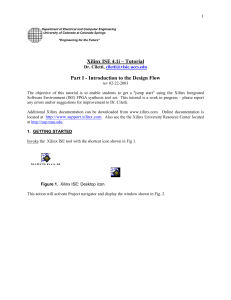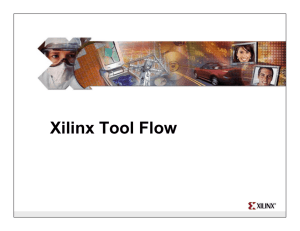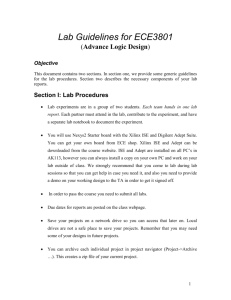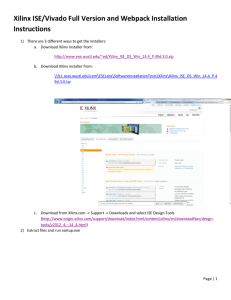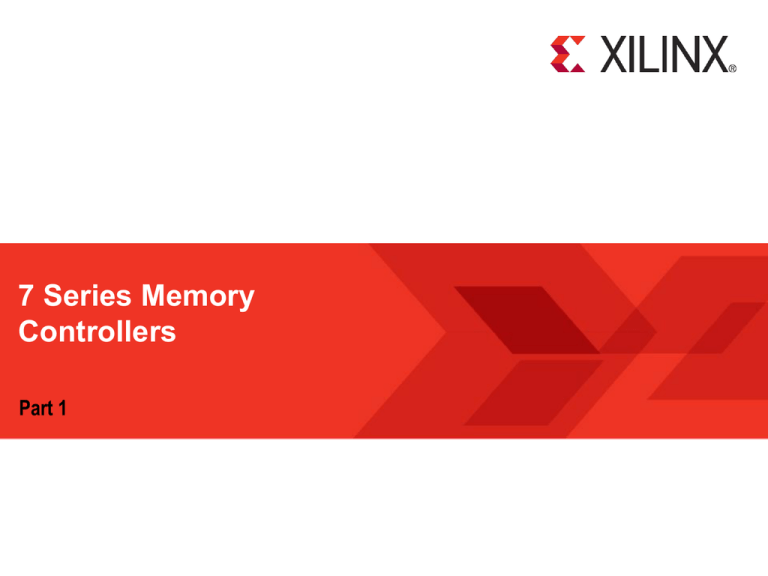
7 Series Memory
Controllers
Part 1
Objectives
After completing this module, you will be able to:
Describe the new I/O features for supporting high speed memory controllers
Memory Controllers - 2
© Copyright 2011 Xilinx
Lessons
Overview
Phaser and I/O FIFOs
Memory Controller
Memory Interface Generator (MIG)
Summary
Memory Controllers - 3
© Copyright 2011 Xilinx
DRAM Technologies
Shipments by Technology Type
DDR3 (1.5V and 1.35V)
1 Gb equivalent Units (Millions)
– Volume leader 2010
– 1866 Mbps for highperformance applications
– DDR4 expected introduction
~2014
DDR2 (1.8V)
20000
18000
DDR3
16000
DDR2
14000
Mobile
12000
10000
– Legacy designs
– Volumes declining
8000
6000
4000
Mobile DRAMs
– LPDDR (1.8V) mobile products
– LPDDR2 (1.2V) emerging in
handsets
2000
0
2007
2008
2009
2010
2011
2012
2013
Data Source: iSuppli
DDR3 is the Majority DRAM Usage for 2011-2013
Memory Controllers - 4
© Copyright 2011 Xilinx
Networking Applications: SRAM and Specialty
DRAM
QDRII+ SRAM
– Table and index storage
– Roadmap driven by QDR Consortium
– QDR-II+ is data rate extension (up to 550 MHz) of QDRII
– QDR-III/IV roadmap planned for higher rates
RLDRAM II → RLDRAM 3
– Packet buffers
– Lower latency and better random access than DDR3
– RLDRAM 3 planned for higher data rate (up to 1866 Mbps)
QDR and RLDRAM Architectures for Networking Applications
Memory Controllers - 5
© Copyright 2011 Xilinx
Data Rate Challenge
DDR Trend
2000Mbps (1000 MHz)
FPGA Fabric Trend
Data Rate (Frequency)
1800Mbps (900 MHz)
1600Mbps (800 MHz)
1400Mbps (700 MHz)
1200Mbps (600 MHz)
1000Mbps (500 MHz)
800Mbps (400 MHz)
600Mbps (300 MHz)
400Mbps (200 MHz)
2005
2006
2007
2008
2009
2010
2011
2012
2013
Data rate increasing at higher rate than fabric performance
Memory Controllers - 6
© Copyright 2011 Xilinx
New Solution Needed
7 series FPGAs require a new approach
– I/O that can keep up with the memory data rates
– Hardened PHY elements to keep up with the I/O rates
– ¼ rate soft controller in fabric (decouple I/O rate from fabric speed)
– Decoupled PHY and controller solution for ease of use
User
Interface
PHY
Memory
Controller
External
Memory
FIFO
New approach for memory controller and PHY design
Memory Controllers - 7
© Copyright 2011 Xilinx
Lessons
Overview
Phaser and I/O FIFOs
Memory Controller
Memory Interface Generator (MIG)
Summary
Memory Controllers - 8
© Copyright 2011 Xilinx
Byte Lanes and DQS
DDR3 memories operate in byte lanes
– Each 8 or 9 bits of data is transmitted/received with a data strobe (DQS)
DQS provides the reference timing for capturing data by the receiver
DQS is a differential bidirectional signal
– On writes it is driven by the controller (FPGA), and must be center aligned with
the DDR data (DQ)
– On reads it is driven by the DDR3 SDRAM chips and is edge aligned with the
change in DDR data (DQ)
Because DQS is not a continually driven clock, a conventional PLL is not
sufficient to extract the capture phase information required
Memory Controllers - 9
© Copyright 2011 Xilinx
PHASER_IN and PHASER_OUT
Clock IN
DQ
DQS
Clock management tile and I/O tightly coupled for higher performance
Memory Controllers - 10
© Copyright 2011 Xilinx
Byte Lane Support
Each byte lane contains 12 pins
– 8 (or 9) DQ data pins
– 2 DQS / DQS# clock capable pins
– 1 DM data mask pin
Byte 0
Byte 1
Each I/O bank supports four byte lanes
Byte 2
– Enabled by larger 50 I/O bank
– Within each byte lane, pins are pre-defined
• See pinout tables for correct connections
To support four lanes in one bank, you must use
an internally generated VREF
– Not enough pins available for external VREF
Memory Controllers - 11
© Copyright 2011 Xilinx
Byte 3
7 Series FPGAs
50 pin IO Bank
Up to 4 Bytes/IO bank
IO FIFO Blocks
IN FIFO per byte group
Data captured/generated by the ISERDES/
OSERDES is running at ½ the rate of the SDRAM
– The read and write data are on separate clocks
The data must be brought into the I/O fabric
– Needs to be at a lower clock rate
– All byte lanes need to be on a common clock
– Managed by the IN_FIFO and OUT_FIFO blocks
IO FIFO Clocking
– Uses DQS PHY aligned clock on I/O side
Uses fixed fabric clock on the fabric side
– Eases fabric design and decouples from I/O side
Provide 1:2 / 2:1 serialization/deserialization
– 233-MHz fabric clock for 1866 Mbps I/O rate
Memory Controllers - 12
© Copyright 2011 Xilinx
OUT FIFO per byte group
Lessons
Overview
Phaser and I/O FIFOs
Memory Controller
Memory Interface Generator (MIG)
Summary
Memory Controllers - 13
© Copyright 2011 Xilinx
Summary
All 7 series FPGAs have dedicated hard logic for implementing the physical
layers of high-speed DDR3 and QDR II+ memory controllers
– PHASER_IN, PHASER_OUT, FIFO_IN, and FIFO_OUT
These blocks work in conjunction with the other logic in the I/O and CMT
columns to generate complete PHY layers for these memories
– ISERDES, OSERDES, PLL
Memory Controllers - 14
© Copyright 2011 Xilinx
Where Can I Learn More?
User Guides
– 7 Series FPGAs Memory Interface Solutions User Guide, UG596
• Describes the complete clocking structures
Xilinx Education Services courses
– www.xilinx.com/training
• Designing with the 7 Series Families course
• Xilinx tools and architecture courses
• Hardware description language courses
• Basic FPGA architecture, Basic HDL Coding Techniques, and other Free RELs!
Memory Controllers - 15
© Copyright 2011 Xilinx
Trademark Information
Xilinx is disclosing this Document and Intellectual Propery (hereinafter “the Design”) to you for use in the development of designs to operate on,
or interface with Xilinx FPGAs. Except as stated herein, none of the Design may be copied, reproduced, distributed, republished, downloaded,
displayed, posted, or transmitted in any form or by any means including, but not limited to, electronic, mechanical, photocopying, recording, or
otherwise, without the prior written consent of Xilinx. Any unauthorized use of the Design may violate copyright laws, trademark laws, the laws of
privacy and publicity, and communications regulations and statutes.
Xilinx does not assume any liability arising out of the application or use of the Design; nor does Xilinx convey any license under its patents,
copyrights, or any rights of others. You are responsible for obtaining any rights you may require for your use or implementation of the Design.
Xilinx reserves the right to make changes, at any time, to the Design as deemed desirable in the sole discretion of Xilinx. Xilinx assumes no
obligation to correct any errors contained herein or to advise you of any correction if such be made. Xilinx will not assume any liability for the
accuracy or correctness of any engineering or technical support or assistance provided to you in connection with the Design.
THE DESIGN IS PROVIDED “AS IS" WITH ALL FAULTS, AND THE ENTIRE RISK AS TO ITS FUNCTION AND IMPLEMENTATION IS WITH
YOU. YOU ACKNOWLEDGE AND AGREE THAT YOU HAVE NOT RELIED ON ANY ORAL OR WRITTEN INFORMATION OR ADVICE,
WHETHER GIVEN BY XILINX, OR ITS AGENTS OR EMPLOYEES. XILINX MAKES NO OTHER WARRANTIES, WHETHER EXPRESS,
IMPLIED, OR STATUTORY, REGARDING THE DESIGN, INCLUDING ANY WARRANTIES OF MERCHANTABILITY, FITNESS FOR A
PARTICULAR PURPOSE, TITLE, AND NONINFRINGEMENT OF THIRD-PARTY RIGHTS.
IN NO EVENT WILL XILINX BE LIABLE FOR ANY CONSEQUENTIAL, INDIRECT, EXEMPLARY, SPECIAL, OR INCIDENTAL DAMAGES,
INCLUDING ANY LOST DATA AND LOST PROFITS, ARISING FROM OR RELATING TO YOUR USE OF THE DESIGN, EVEN IF YOU HAVE
BEEN ADVISED OF THE POSSIBILITY OF SUCH DAMAGES. THE TOTAL CUMULATIVE LIABILITY OF XILINX IN CONNECTION WITH
YOUR USE OF THE DESIGN, WHETHER IN CONTRACT OR TORT OR OTHERWISE, WILL IN NO EVENT EXCEED THE AMOUNT OF
FEES PAID BY YOU TO XILINX HEREUNDER FOR USE OF THE DESIGN. YOU ACKNOWLEDGE THAT THE FEES, IF ANY, REFLECT
THE ALLOCATION OF RISK SET FORTH IN THIS AGREEMENT AND THAT XILINX WOULD NOT MAKE AVAILABLE THE DESIGN TO YOU
WITHOUT THESE LIMITATIONS OF LIABILITY.
The Design is not designed or intended for use in the development of on-line control equipment in hazardous environments requiring fail-safe
controls, such as in the operation of nuclear facilities, aircraft navigation or communications systems, air traffic control, life support, or weapons
systems (“High-Risk Applications”). Xilinx specifically disclaims any express or implied warranties of fitness for such High-Risk Applications. You
represent that use of the Design in such High-Risk Applications is fully at your risk.
© 2009 Xilinx, Inc. All rights reserved. XILINX, the Xilinx logo, and other designated brands included herein are trademarks of Xilinx, Inc. All
other trademarks are the property of their respective owners.
Memory Controllers - 16
© Copyright 2011 Xilinx
7 Series Memory
Controllers
Part 2
Objectives
After completing this module, you will be able to:
Describe the Memory Interface Generator (MIG) design flow
Memory Controllers - 18
© Copyright 2011 Xilinx
Lessons
Overview
Phaser and I/O FIFOs
Memory Controller
Memory Interface Generator (MIG)
Summary
Memory Controllers - 19
© Copyright 2011 Xilinx
Memory Controller Operations
Users normally want external memory to be a single flat memory space
DDR3 SDRAM is organized into banks, pages, and words
– Different operations are required to access data
•
•
•
•
ACTIVATE to open a page in a bank
PRECHARGE to close a page in a bank
READ/WRITE to access/modify data in an open page
REFRESH to refresh the dynamic RAM cells
– Timing between commands is complex and crucial
• ACTIVATE to READ, READ to WRITE, for example
Page management is complex and can have a significant impact on overall
performance
– No one page management policy is ideal for all applications
This is an ideal application for fabric logic
Memory Controllers - 20
© Copyright 2011 Xilinx
MIG Memory Controller
A DDR3 memory controller is provided through the
Memory Interface Generator
DDR3 Memory
Controller
Leveraged from the Virtex®-6 FPGA DDR3 reordering
controller architecture
Reordering
Bank Machines
¼ Rate
– Programmable bank machines for high efficiency
Advanced features
– One quarter rate for higher data rates (up to 1866 Mbps)
with the 28-nm fabric speed
– Self refresh for lower memory power consumption
Memory Controllers - 21
© Copyright 2011 Xilinx
User Interfaces
Two user interfaces are provided by the MIG memory controller
– Native user interface
• Leveraged from the Virtex-6 FPGA MIG memory controller
• Can be used in legacy designs
– AXI4 Interface
• Utilizes the AXI4 protocol
• Xilinx recommends for new designs
• Required for multi-port designs
Both solutions provide a single high-speed, wide interface to the memory
controller
Memory Controllers - 22
© Copyright 2011 Xilinx
Multi-Port Support
AXI4 is, by nature, a point-to-point protocol
– Complex systems are built using AXI interconnect blocks
An AXI4 interconnect block can be used to create a multi-port memory
controller
– Provides a configurable number of AXI4 protocol user ports
– Each port is independent, but accesses underlying memory controller
• Different clocks and port widths are supported
AXI4 User
Interface
Ports
Memory Controllers - 23
AXI
4Interconnect
Block
Memory
Controller
AXI4
© Copyright 2011 Xilinx
External
Memory
Lessons
Overview
Phaser and I/O FIFOs
Memory Controller
Memory Interface Generator (MIG)
Summary
Memory Controllers - 24
© Copyright 2011 Xilinx
Memory Interface Generator (MIG)
Customize your memory controller and interface design
– Memory architecture, data rate, bus width
– CAS latency, burst length
– I/O bank assignments
– Generates RTL source code and UCF from hardware-verified IP
Delivered as part of the ISE® software (CORE Generator™ interface)
Memory interfaces supported for 7 series FPGAs
– DDR3 SDRAM
– QDRII+ SRAM
– RLDRAM II
Memory Controllers - 25
© Copyright 2011 Xilinx
MIG Design Flow
Open CORE Generator interface
Integrate MIG .ucf constraints to
overall design constraints file
Run MIG, choose your memory
parameters and generate rtl and ucf files
Import RTL and build options into
ISE project
Synthesize design
Customize MIG design
Place and route design
Integrate/customize MIG memory RTL
testbench
Timing simulation
Perform functional simulation
Verify in hardware
Optional RTL customization
Memory Controllers - 26
© Copyright 2011 Xilinx
MIG Runs Through the CORE Generator
Interface
Settings for the
CORE Generator
interface for
device and design
entry
Memory Controllers - 27
© Copyright 2011 Xilinx
MIG Memory Selection
Check marks to
indicate which
step you are on
and what is next
Memory Controllers - 28
© Copyright 2011 Xilinx
AXI Interface Options
Options for the
AXI4 user interface,
if selected
Memory Controllers - 29
© Copyright 2011 Xilinx
MIG Memory Options
Options for
DDR3 mode
register settings
Memory Controllers - 30
© Copyright 2011 Xilinx
MIG FPGA Options
Options for
FPGA controller
and physical
layer settings
Memory Controllers - 31
© Copyright 2011 Xilinx
MIG Bank Selection
Allows you to choose which banks and byte lanes will be used for the
interface
Memory Controllers - 32
© Copyright 2011 Xilinx
Lessons
Overview
Phaser and I/O FIFOs
Memory Controller
Memory Interface Generator (MIG)
Summary
Memory Controllers - 33
© Copyright 2011 Xilinx
Summary
These resources are used by the soft memory controller generated by the
Memory Interface Generator (MIG)
– The MIG generates a complete memory controller with either a native user
interface or an AXI4 user interface
Memory Controllers - 34
© Copyright 2011 Xilinx
Where Can I Learn More?
User Guides
– 7 Series FPGAs Memory Interface Solutions User Guide, UG596
• Describes the complete clocking structures
Xilinx Education Services courses
– www.xilinx.com/training
• Designing with the 7 Series Families course
• Xilinx tools and architecture courses
• Hardware description language courses
• Basic FPGA architecture, Basic HDL Coding Techniques, and other Free RELs!
Memory Controllers - 35
© Copyright 2011 Xilinx
Trademark Information
Xilinx is disclosing this Document and Intellectual Propery (hereinafter “the Design”) to you for use in the development of designs to operate on,
or interface with Xilinx FPGAs. Except as stated herein, none of the Design may be copied, reproduced, distributed, republished, downloaded,
displayed, posted, or transmitted in any form or by any means including, but not limited to, electronic, mechanical, photocopying, recording, or
otherwise, without the prior written consent of Xilinx. Any unauthorized use of the Design may violate copyright laws, trademark laws, the laws of
privacy and publicity, and communications regulations and statutes.
Xilinx does not assume any liability arising out of the application or use of the Design; nor does Xilinx convey any license under its patents,
copyrights, or any rights of others. You are responsible for obtaining any rights you may require for your use or implementation of the Design.
Xilinx reserves the right to make changes, at any time, to the Design as deemed desirable in the sole discretion of Xilinx. Xilinx assumes no
obligation to correct any errors contained herein or to advise you of any correction if such be made. Xilinx will not assume any liability for the
accuracy or correctness of any engineering or technical support or assistance provided to you in connection with the Design.
THE DESIGN IS PROVIDED “AS IS" WITH ALL FAULTS, AND THE ENTIRE RISK AS TO ITS FUNCTION AND IMPLEMENTATION IS WITH
YOU. YOU ACKNOWLEDGE AND AGREE THAT YOU HAVE NOT RELIED ON ANY ORAL OR WRITTEN INFORMATION OR ADVICE,
WHETHER GIVEN BY XILINX, OR ITS AGENTS OR EMPLOYEES. XILINX MAKES NO OTHER WARRANTIES, WHETHER EXPRESS,
IMPLIED, OR STATUTORY, REGARDING THE DESIGN, INCLUDING ANY WARRANTIES OF MERCHANTABILITY, FITNESS FOR A
PARTICULAR PURPOSE, TITLE, AND NONINFRINGEMENT OF THIRD-PARTY RIGHTS.
IN NO EVENT WILL XILINX BE LIABLE FOR ANY CONSEQUENTIAL, INDIRECT, EXEMPLARY, SPECIAL, OR INCIDENTAL DAMAGES,
INCLUDING ANY LOST DATA AND LOST PROFITS, ARISING FROM OR RELATING TO YOUR USE OF THE DESIGN, EVEN IF YOU HAVE
BEEN ADVISED OF THE POSSIBILITY OF SUCH DAMAGES. THE TOTAL CUMULATIVE LIABILITY OF XILINX IN CONNECTION WITH
YOUR USE OF THE DESIGN, WHETHER IN CONTRACT OR TORT OR OTHERWISE, WILL IN NO EVENT EXCEED THE AMOUNT OF
FEES PAID BY YOU TO XILINX HEREUNDER FOR USE OF THE DESIGN. YOU ACKNOWLEDGE THAT THE FEES, IF ANY, REFLECT
THE ALLOCATION OF RISK SET FORTH IN THIS AGREEMENT AND THAT XILINX WOULD NOT MAKE AVAILABLE THE DESIGN TO YOU
WITHOUT THESE LIMITATIONS OF LIABILITY.
The Design is not designed or intended for use in the development of on-line control equipment in hazardous environments requiring fail-safe
controls, such as in the operation of nuclear facilities, aircraft navigation or communications systems, air traffic control, life support, or weapons
systems (“High-Risk Applications”). Xilinx specifically disclaims any express or implied warranties of fitness for such High-Risk Applications. You
represent that use of the Design in such High-Risk Applications is fully at your risk.
© 2009 Xilinx, Inc. All rights reserved. XILINX, the Xilinx logo, and other designated brands included herein are trademarks of Xilinx, Inc. All
other trademarks are the property of their respective owners.
Memory Controllers - 36
© Copyright 2011 Xilinx



